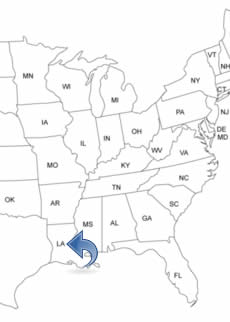LOUISIANA PEOPLE SEARCH!
- ✔ Contact Info
- ✔ Phone Numbers
- ✔ Criminal Records
- ✔ Income Info
- ✔ Neighbors
- ✔ People's Age
- ✔ Property Ownership
- ✔ And Much More
New Orleans, Louisiana
New Orleans is located in the southeastern part of and is the largest city in the U.S. State of Louisiana. New Orleans is known for its cross-cultural and multilingual heritage, and for its distinct French Creole architecture. New Orleans is also famous for its cuisine, music, the birthplace of jazz, and its annual celebrations and festivals like Mardi Gras.
To See And To Do In New Orleans
- Carriage Rides
- Live Music
- Bourbon Street
- Royal Street
- Jackson Square
- Cabildo
- New Orleans Jazz Park-
Visitor's Center and Headquarters - St. Louis Cathedral
- Pontalba Buildings
- Moon Walk
- Old French Market
- Lower Decatur Street
- Jean Lafitte National Park and Preserve
- Historic New Orleans Collection
- Cigar Factory New Orleans and Museum
- Musee Conti Wax Museum
- Mardi Gras World
- Canal Street
- Poydras Street
- Loyola Ave
- St. Charles Ave
- Magazine Street
- The Marigny's Frenchmen Street
- Riverboat cruises
History Of New Orleans - Timeline
In 1682, the French lay claims to the region. In 1699, the French Canadian Pierre D'Iberville establishes a camp called Point du Mardi Gras 60 miles below the present-day New Orleans. New Orleans was founded in 1718 by the French as La Nouvelle-Orléans. In 1722 New Orleans became the capital of Louisiana. In 1745, the first building for the Ursuline nuns was built. The town was ceded to the Spanish Empire in 1763.
In 1788, a fire destroyed more than 800 buildings in the town. In 1792, Theatre de la Rue Saint Pierre opened. It was located between Royal & Bourbon Streets, in what is now the French Quarter. In 1794, the St. Louis Cathedral and the Carondelet Canal was completed. The same year a fire destroyed more than 200 buildings in the French Quarter area.
In 1800, about 10,000 people lived in the city. In 1801, the French took control over the town again. In 1803, Napoleon sold the territory to the United States. In 1804, Orleans Gazette newspaper was published. The Haitian Revolution of 1804 forced people to flee and many Haitian refugees settled in New Orleans. British forces tried to conquer New Orleans in 1812. But in 1815, the British were defeated.
In 1818, Fort Pike was built. It was built to guard against British reinvasion of the United States. In 1827, the Canal Street Ferry/Algiers Ferry service started. In 1834, the Tulane University was established. The New Orleans Mint was also established. It produced gold and silver coins.
In 1835, the railroad arrived. In 1837, the Christ Church Cathedral was built, and in 1838, the St. Vincent De Paul Roman Catholic Church was built, and in 1840, the St. Patrick's Church was built. In 1845, the Gallier Hall was built. It is the former city hall.
The flood of 1849 was of a more disastrous scale than any save the flooding after Hurricane Katrina in 2005. The flood, known as at Sauvé's Crevasse, left 12,000 people homeless. In 1850, telegraphic communication was established and in 1851 the railroad started to be built. In 1853, almost 10,000 New Orleans citizens die from yellow fever. In 1859, the French Opera House opened. It stood in the French Quarter. In 1862, Union forces occupied the city without resistance.
In 1868, Straight University was founded. It was a historically black college. In 1880, the Commander's Palace was built. It was first a small saloon and later a restaurant. An electric lighting system was introduced to the city in 1886, and in 1890, much of the city's public transportation system was electrified. In 1892, the New Orleans Union Station opened. In 1893, the city had electric streetcars and the Roosevelt New Orleans Hotel opened in as "The Grunewald".
In 1900, the African American laborer Robert Charles shot a white police officer. The manhunt for Charles began and in a few days, Charles had killed 27 white people before he was shot by a member of the special police. In 1921, the Orpheum Theater opened. In 1926, the State Palace Theatre opened, and in 1927, the Saenger Theatre opened. In 1946, the Louis Armstrong New Orleans International Airport opened as "Moisant International Airport".
In 1958, the Greater New Orleans Bridge opened. (Crescent City Connection). In the 1960s, the Canal Streetcar Line was replaced with buses. In 1965, the Rock ‘n’ Roll Mardi Gras Marathon was held for the first time.
In 1969, the construction of the Plaza Tower was completed. In 1970, the first "The New Orleans Jazz & Heritage Festival" was held. In 1973, 32 people were killed at a gay bar when someone set the building on fire. Rodger Dale Nunez later confessed to the deed to his friends and he later killed himself.
In 1975, the Mercedes-Benz Superdome opened. In 1991, the full-time, professional orchestra "Louisiana Philharmonic Orchestra" was formed. In August 2005 New Orleans and the surrounding area was hit by hurricane Katrina and about 80% of the city flooded. Due to the hurricane Katrina, 3.000 city employees lost their jobs.

